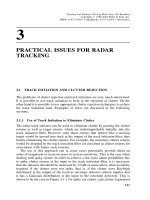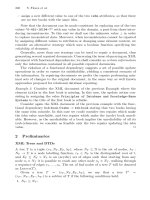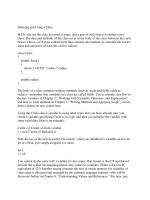Tài liệu Urbanization and Urban Air Pollution pdf
Bạn đang xem bản rút gọn của tài liệu. Xem và tải ngay bản đầy đủ của tài liệu tại đây (270.99 KB, 5 trang )
Can urbanization
serve as an
indicator of
development?
55
10
Urbanization is a process of relative
growth in a country’s urban population
accompanied by an even faster increase
in the economic, political, and cultural
importance of cities relative to rural
areas. There is a worldwide trend toward
urbanization. In most countries it is a
natural consequence and stimulus of
economic development based on
industrialization and postindustrial-
ization (see Chapter 9). Thus the level
of urbanization, as measured by the
share of a country’s urban population in
its total population, is highest in the
most developed, high-income countries
and lowest in the least developed, low-
income countries (see Data Table 2).
At the same time, urbanization is pro-
gressing much faster in developing
countries than in developed countries
(Figure 10.1). In 1990–95 the average
annual growth of the urban population
in low-income countries was 3.8 percent
and in middle-income countries, 3.1
percent, compared with 0.1 percent in
high-income countries. Because the
developing world has a larger popula-
tion, percentages of its population also
represent more people. As a result, by
1995 almost three-quarters of the
world’s 2.5 billion urban residents lived
in developing countries. The share of the
urban population in the total population
of low- and middle-income countries
increased from less than 22 percent in
1960 to 39 percent in 1995 and is
expected to exceed 50 percent by 2015.
A rough indication of the urban contri-
bution to GDP is the combined share of
GDP produced in the industry and ser-
Urbanization and Urban Air
Pollution
1980 1995
Figure 10.1
Urban population, 1980 and 1995
400
600
501
603
639
962
912
680
800
1000
Millions of urban residents
Middle-income countries
Low-income countries
High-income countries
BEYOND ECONOMIC GROWTH
Why is urban air
pollution often
higher in
developing
countries?
56
vice sectors relative to agriculture. Judging
by this indicator, cities in developing
countries are already more economically
important than rural, primarily agricul-
tural areas, because more than half of the
developing world’s GDP originates in
cities. (This is not yet true for every coun-
try, as you can see in Data Table 2.)
While urbanization is characteristic of
nearly all developing countries, levels of
urbanization vary quite significantly by
region (Figure 10.2). Most Latin
American countries are as urbanized as
Europe, with 74 percent of the popula-
tion living in urban areas. But South
Asia, East Asia, and Sub-Saharan Africa
remain predominantly rural, though
they are urbanizing rapidly.
Most of the world’s most populous cities
are in developing countries. Many of these
cities are in Asian countries with low per
capita incomes but big populations, such
as China, India, and Indonesia. These
cities have high concentrations of poor
residents and suffer from social and envi-
ronmental problems including severe air
pollution (Table 10.1).
Particulate Air Pollution
Suspended particulate matter is made up
of airborne smoke, soot, dust, and liquid
droplets from fuel combustion. The
amount of suspended particulate matter,
usually measured in micrograms per cubic
meter of air, is one of the most important
Figure 10.2
Urban population as a percentage of total population,
1980 and 1995
0
20
40
60
80
1980
South
Asia
22%
26%
21%
31%
23%
31%
48%
57%
58%
65%
65%
74%
75%
78%
East Asia
and the
Pacific
Sub-
Saharan
Africa
Middle East
and
North Africa
Europe
and
Central Asia
Latin America
and the
Caribbean
High-
income
countries
1995
10 URBANIZATION AND URBAN AIR POLLUTION
57
indicators of the quality of the air that
people breathe. According to the World
Health Organization’s air quality stan-
dards, the concentration of suspended
particulates should be less than 90 micro-
grams per cubic meter. In many cities,
however, this number is several times
higher (Map 10.1; see also Table 10.1).
High concentrations of suspended par-
ticulates adversely affect human health,
provoking a wide range of respiratory
diseases and exacerbating heart disease
and other conditions. Worldwide, in
1995 the ill health caused by such pollu-
tion resulted in at least 500,000 prema-
ture deaths and 4–5 million new cases of
chronic bronchitis.
Most of the people at risk are urban
dwellers in developing countries, espe-
cially China and India. In many Chinese
cities air quality is so poor that nation-
wide, the costs of excess morbidity and
mortality for urban residents are esti-
mated at 5 percent of GDP. According
to estimates for 18 cities in Central and
Eastern Europe, 18,000 premature
deaths a year could be prevented and
$1.2 billion a year in working time lost
to illness could be regained by achieving
European Union pollution standards for
dust and soot.
The level of air pollution depends on a
country’s technology and pollution con-
trol, particularly in energy production.
Using cleaner fossil fuels (such as nat-
ural gas and higher-grade coal), burning
these fuels more efficiently, and increas-
ing reliance on even cleaner, renewable
sources of energy (hydro, solar, geother-
mal, wind) are some of the best ways to
control and reduce air pollution without
limiting economic growth. See Figure
10.3 for the main sources of electricity
in China, Russia, and the United States.
Compare these data to the concentra-
tions of suspended particulates in the
Table 10.1 Particulate air pollution in the largest cities, 1995
SPM
City population (micrograms
Country City (thousands) per m
3
)
Brazil São Paolo 16,533 86
Rio de Janeiro 10,187 139
China Shanghai 13,584 246
Beijing 11,299 377
Tianjin 9,415 306
Egypt, Arab Rep. Cairo 9,690 —
France Paris 9,523 14
India Mumbai 15,138 240
Calcutta 11,923 375
Delhi 9,948 415
Indonesia Jakarta 8,621 271
Japan Tokyo 26,959 49
Osaka 10,609 43
Korea, Rep. Seoul 11,609 84
Mexico Mexico City 16,562 279
Philippines Manila 9,286 200
Russian Federation Moscow 9,269 100
Turkey Istanbul 7,911 —
United Kingdom London 7,640 —
United States New York
(1987–90) 16,332 61
Los Angeles 12,410 —
— No data.
Note: Selected are the cities with more than 7 million residents.
BEYOND ECONOMIC GROWTH
58
biggest cities of these three countries as
shown in Table 10.1. Note that coal is
considered to be the “dirtiest” of the
sources shown, although a lot depends
on its quality and methods of combus-
tion. In many ways nuclear energy is one
of the “cleanest” sources of electricity,
but safe disposal of nuclear waste and
the risks of radioactive pollution in case
of a serious accident are of major con-
cern. Sources with the least environmen-
tal impact, such as solar energy, are not
shown because they account for only a
small fraction of generated electricity
worldwide.
Fuel combustion by motor vehicles is
another major source of suspended par-
ticulate emissions in urban areas. These
emissions are particularly detrimental to
human health because pollutants are
emitted at ground level. Motor vehicles
are much more common in developed
countries: in 1996 there were 559 of
them per 1,000 people in high-income
countries compared with just 8 per
1,000 people in low-income countries
and 91 in middle-income countries. (See
Data Table 2 for the number of motor
vehicles in individual countries.) But
motor vehicles in developing countries
Map 10.1
Particulate air pollution in selected cities, 1995 or most recent estimates
Moscow
Seoul
Jakarta
Mexico City
New York
Sгo Paulo
Rio de Janeiro
Paris
Mumbai
Tokyo
Osaka
Manila
Delhi
Calcutta
Shanghai
Beijing
Tianjin
90 or less91–199200–299Micrograms per m
3
300 or more
10 URBANIZATION AND URBAN AIR POLLUTION
Is it possible to
reduce air
pollution without
slowing economic
growth?
59
still cause serious air pollution because
they are concentrated in a few large
cities, many are in poor mechanical con-
dition, and few emission standards exist.
According to World Bank estimates,
demand for gasoline in developing coun-
tries tends to grow 1.2–1.9 times faster
than GNP per capita. If per capita
income growth rates of 6–8 percent a
year are typical of industrializing and
urbanizing countries, growth rates in
motive fuel consumption of 10–15 per-
cent a year are possible. In many transi-
tion countries in the late 1980s and early
1990s, the number of cars in use grew
rapidly despite the contraction in eco-
nomic activity and reduced per capita
incomes. In Moscow (Russia) the pas-
senger car fleet grew 10 percent a year
during 1984–94 and 17.5 percent a year
during 1990–94. Without effective poli-
cies to curb motor vehicle emissions,
such dynamics can lead to grave health
consequences for urban populations.
Airborne Lead Pollution
Airborne lead is one of the most harmful
particulate pollutants. Young children
are especially vulnerable: lead poisoning
of children leads to permanent brain
damage, causing learning disabilities,
hearing loss, and behavioral abnormali-
ties. In adults lead absorption causes
hypertension, blood pressure problems,
and heart disease. The main sources of
airborne lead are motor vehicles using
leaded gasoline, industrial processes such
as ferrous and nonferrous metallurgy,
and coal combustion.
While governments increasingly control
large industrial sources of pollution,
motor traffic is rapidly growing. In
Figure 10.3
Sources of electricity in selected countries, 1995
Russia
United States
China
Hydropower
Coal
Oil
Natural gas Nuclear power
18.9%
73.4%
6.1%
0.2%
1.3%
20.5%
18.3%
40.1%
11.6%
8.8%
51.5%
2.5%
14.9%
20.1%
Note: Percentages may not total 100 because of rounding and because other sources of electricity (such as geothermal power,
solar power, and wind) are not shown.
9.2%









